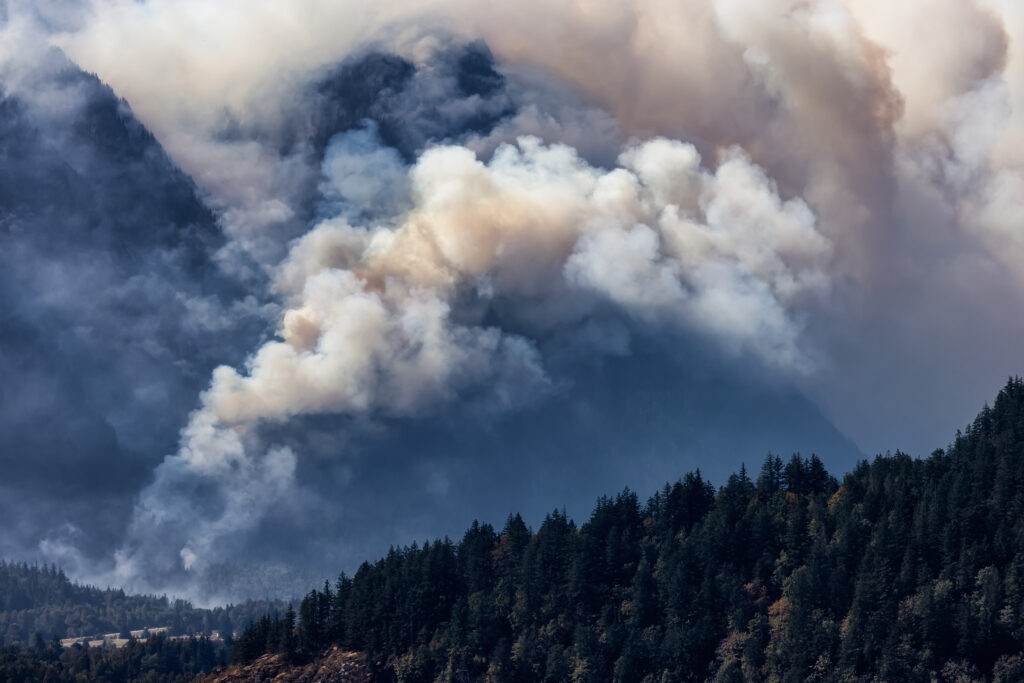
Features
Opinions
Opinion: This forest fire season is war
September 21, 2023 By Tony Rotherham
 Forest fire and smoke near Hope, B.C. Photo: Adobe Stock.
Forest fire and smoke near Hope, B.C. Photo: Adobe Stock. As seen from early September 2023, this forest fire season looks more like a war than a traditional fire season. Huge areas of forest have burned, not only in Canada but also across the mainland U.S and Hawaii, Greece, the Canary Islands, and other countries in southern Europe. Rural communities have burned and suffered great losses of family homes, possessions, and equipment. Several towns were evacuated in the NWT and in the southern B.C. Interior. There have been several deaths and water bomber crashes.
What should we do in Canada?
We must decide that real action is required. Our usual national thumb-twiddling naivety must be put aside and replaced with analysis of the costs and losses caused by this fire season.
Based on a careful analysis of the magnitude of the losses and costs we must take the decisive action that is indicated.
- First, I suggest a joint venture with all national and provincial governments and forest industry associations, and perhaps the provincial professional foresters associations, to contribute to gathering information and participation in analysis and recommendations.
- Second is assessment of the losses and costs caused by the fires. This should be carried out on a provincial basis. The Canadian Forest Service is a good source of historic data, useful to underscore the magnitude of areas burned in 2023, but information on 2023 losses of all types will be available first from provincial government sources.
- Third is decisive action to get ready for another fire season like we are having right now.
Consultation with the Canadian Council of Forest Ministers (CCFM) and the Canadian Interagency Forest Fire Centre (CIFFC) in Winnipeg is of great importance to ensure that there is national (Federal and provincial) support for any action that is recommended.
The points below must be discussed, questions must be answered and we should come up with solutions:
- Losses and costs in each province and territory compared to the 10-year average and previous bad years.
- What is the total area of forests burned in each province and territory?
- How much timber-productive forest land has been burned in each province and territory?
- How much remote northern forest land has been burned in each province and territory?
- What is the effect on AAC and timber supply for industry? Fast decisions on salvage are needed.
- What area must be planted to ensure prompt regeneration?
- What area of natural regeneration can we count on?
- A review and statement of loss in national parks, provincial parks and conservation areas would be helpful.
- How many houses and farm buildings burned?
- How many other buildings and infrastructure lost?
- Losses of off-road equipment – forest harvesting equipment, agricultural tractors, etc, as well as mining and other resource extraction equipment.
- Costs of fire detection and suppression by Canadian services.
- Costs and scope of international assistance- fire fighters and equipment sent to Canada to assist in fire suppression.
- What is the state of our fleet of water bombers? How many new aircraft do we need and when can we get them? European countries have ordered 29 new water bombers from De Havilland, while Canada has not. The same neglect has led to a decline in our defence forces and failure to meet our NATO commitments.
- The cost of quick suppression by big water bombers may be high but it should be compared to the costs of an eight-month fire-fighting season and the immense costs of the loss of forest and houses and disruption the lives of people and wildlife from fires that get out of control.
- The climate change aspect to our experience in 2023 – the burning forest has generated and released a lot of CO2 to the atmosphere. Much of the warm, dry weather that has multiplied the fire loss has been attributed to climate change.
Tony Rotherham (RPF B.C. and Ont. (ret’d)) has worked on woodlands operations in B.C., Ontario, and Quebec, as well as in Kenya and Iran. He worked for the CPPA (now FPAC) in the woodlands section for 21 years until 2001.
Print this page